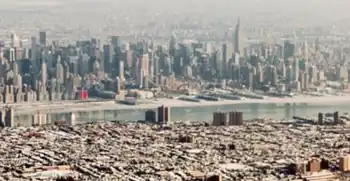Core city
In urban planning, a historic core city or central city is the municipality with the largest 1940 population in the present metropolitan area (metropolitan statistical area).[1][2] This term was retired by the US census bureau and replaced by the term principal city, which can include historic core cities and post WW2 cities. Metropolitan areas are no longer considered monocentric, but had become polycentric due to suburbanization of employment.[3][4] A historic core city is not to be confused with the core of a metropolitan area which is defined as an urban area with a population of over 50,000 by the US census bureau.[5] Historic core cites in the United States often times have higher detached single family housing rates, lower density and fewer jobs than surrounding satellite cities and suburbs.[6][7][8] A central city is usually the first settlement established in an urban region before the outlying districts came into existence, later in history. These cities typically contain less economic activity and more crime than their surrounding areas.[9][10][11][12][13] Central cities often form the regional downtowns of metro areas. The term is used mainly in US context, although since the 1970s it has also become relatively common in Canada and, to a lesser extent, Europe and Australia.[14][15][16][17]

Examples
Metropolitan areas with one core city
The followings are the core city of the five largest metropolitan areas in the world.
| Metropolitan area | Core city | Country | Metropolitan population | |
|---|---|---|---|---|
| Name | Location | |||
| Greater Tokyo Area (Kantō region) |
Tokyo | 35°41′23″N 139°41′32″E | 37,274,000[18] | |
| Jakarta metropolitan area (Jabodetabekpunjur) |
Jakarta | 6°10′30″S 106°49′43″E | 33,430,285[19] | |
| Central National Capital Region (Delhi Metropolitan Area) |
Delhi | 28°36′36″N 77°13′48″E | 29,000,000[20] | |
| Seoul Capital Area (Sudogwon region) |
Seoul | 37°34′N 126°58′E | 25,514,000[21] | |
| Mumbai Metropolitan Region
(मुंबई महानगर प्रदेश) |
Mumbai, Maharashtra | 18°58′30″N 72°49′33″E | 24,400,000[22] | |
Metropolitan areas with more than one core city
| Metropolitan area | Core cities | Country | Metropolitan population | |
|---|---|---|---|---|
| Name | Location | |||
| Dallas–Fort Worth metroplex | Dallas | 32°46′45″N 96°48′32″W | 7,470,158[23] | |
| Fort Worth | 32°45′N 97°20′W | |||
| Rhine-Ruhr metropolitan region | Essen | 51°27′3″N 7°0′47″E | 1,555,985[24] | |
| Düsseldorf | 51°14′N 6°47′E | |||
| Islamabad–Rawalpindi metropolitan area | Islamabad | 33°41′35″N 73°03′50″E | 4,500,000[25] | |
| Rawalpindi | 33°36′N 73°02′E | |||
See also
References
- https://www.newgeography.com/content/002401-suburbanized-core-cities
- "Principal Cities 2012 Demographic Economic Patterns General Demographics".
- https://www.newgeography.com/content/004453-urban-cores-core-cities-and-principal-cities
- https://www2.census.gov/geo/pdfs/reference/GARM/Ch13GARM.pdf
- "Federal Register/Vol. 75, No. 123/Monday, June 28, 2010/Notices" (PDF). US Census Bureau. Retrieved July 22, 2023.
- "American community survey housing data". US Census Bureau. Retrieved October 4, 2023.
- "Suburbs continue to Dominate Jobs and Job Growth". new geography. Retrieved October 4, 2023.
- "population per square mile Phoenix Metro area". statistical atlas. Retrieved October 4, 2023.
- "St Louis City Gross Domestic Product". Fred economic data. Retrieved October 7, 2023.
- "St Louis MO-IL metro area Gross Domestic Product". Fred economic data. Retrieved October 7, 2023.
- "San Fransisco City GDP". Fred economic data. Retrieved October 7, 2023.
- "San Fransisco-Oakland-Hayward MSA Gross Domestic Product". Fred Economic Data. Retrieved October 7, 2023.
- "Why is crime higher in cities?". Tommorow City. Retrieved October 7, 2023.
- Caves, R. W. (2004). Encyclopedia of the City. Routledge. p. 72.
- "Central city definition and meaning | Collins English Dictionary".
- "Definition of CENTRAL CITY". www.merriam-webster.com.
- "Principal Cities 2012 Demographic Economic Patterns General Demographics". proximityone.com.
- "Table 2.10 Population of Three Major Metropolitan Areas" (PDF). Statistics Bureau of Japan. p. 21. Retrieved 26 November 2013.
- "Jabodetabekpunjur". perkotaan.bpiw.pu.go.id. Ministry of Public Works and People's Housing. Archived from the original on 6 February 2020. Retrieved 22 February 2020.
- Sharma, Shantanu Nandan (February 17, 2019). "Delhi could be the world's most populous city by 2028. But is it really prepared?". The Economic Times.
- ???? : ???? ???? (in Korean). Ministry of Government Administration and Home Affairs. Archived from the original on 3 March 2011. Retrieved 4 April 2015.
- https://portal.mcgm.gov.in/irj/go/km/docs/documents/MCGM%20Department%20List/Roads%20and%20Traffic/Docs/CMP%20for%20Greater%20Mumbai/Executive%20Summary/Executive%20Summary.pdf
- "Dallas - Fort Worth - Arlington (Metropolitan Statistical Area, Metropolitan Areas, USA) - Population Statistics, Charts, Map and Location". www.citypopulation.de.
- "Metropolitan Area Populations". Eurostat. 18 June 2019. Retrieved 4 December 2019.
- "Box-1: Rawalpindi–Islamabad Metrobus Project" (PDF). Ministry of Finance and Revenue. 30 June 2014. p. 197. Retrieved 11 March 2020.
Further reading
- OECD (2020). Urban Policy Reviews: Enhancing Productivity in UK Core Cities. OECD Publishing. ISBN 9789264882140.
- Parkinson, Michael (2004). Competitive European Cities: Where Do the Core Cities Stand?. Office of the Deputy Prime Minister. ISBN 9781851126903.